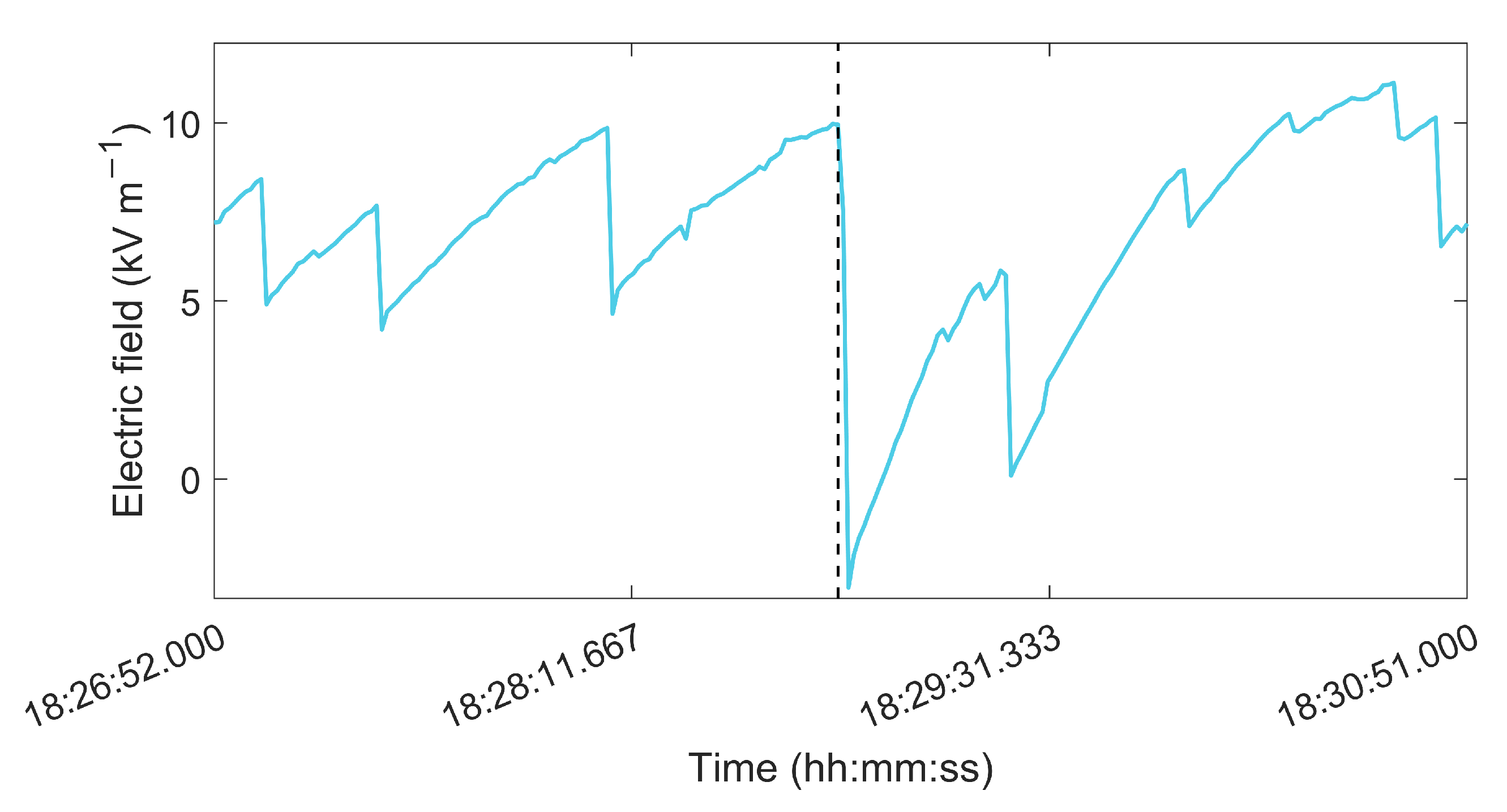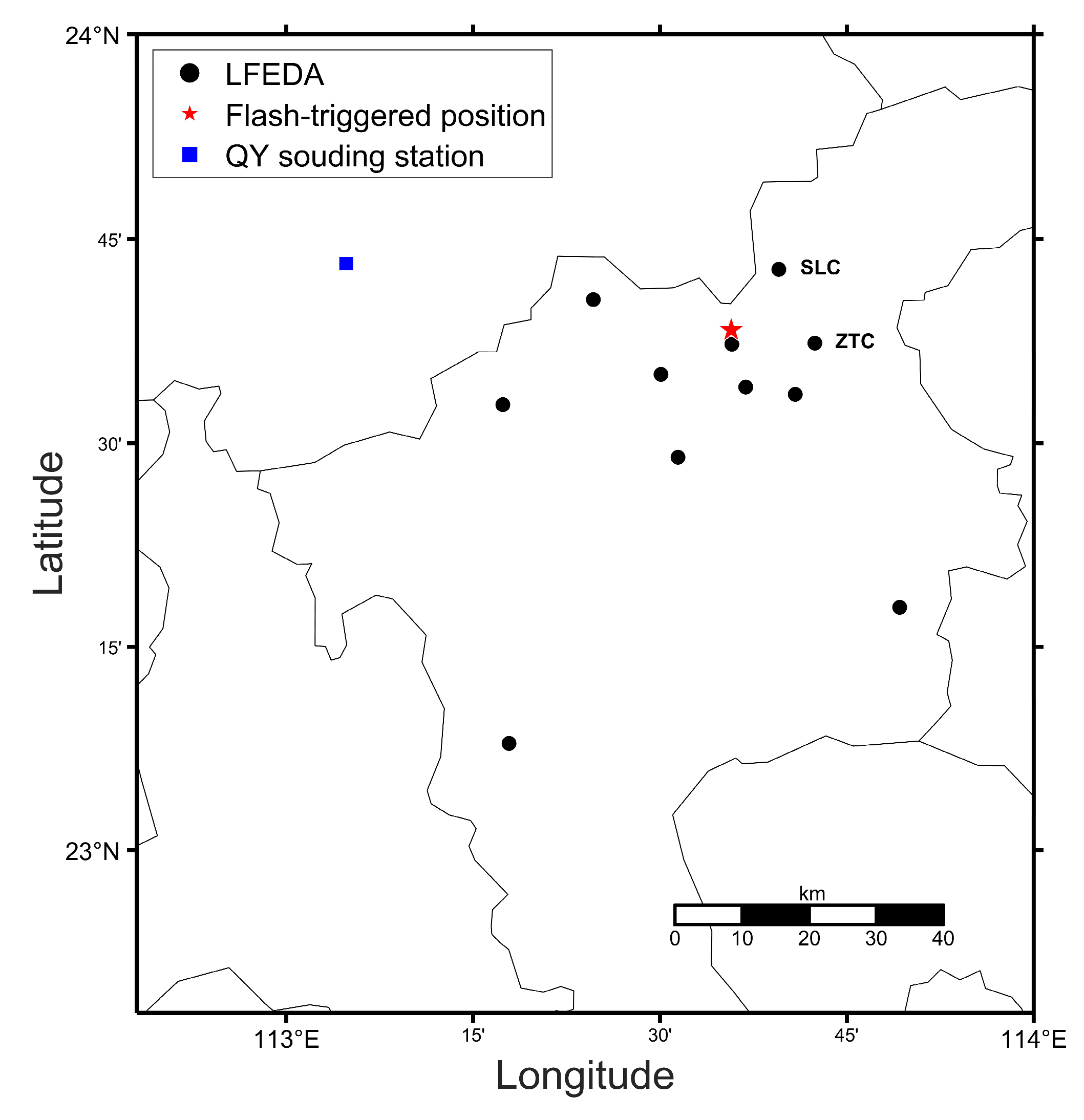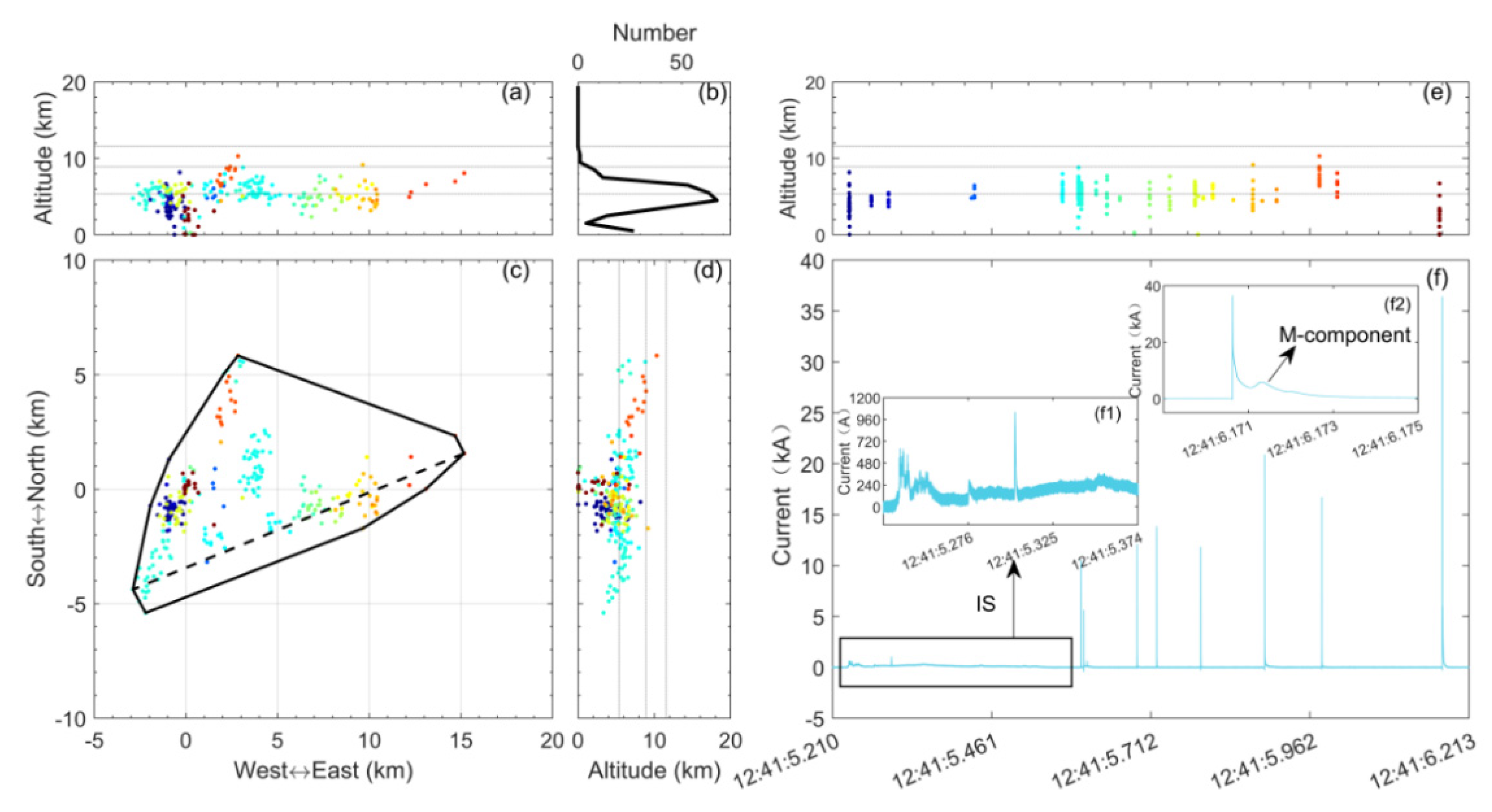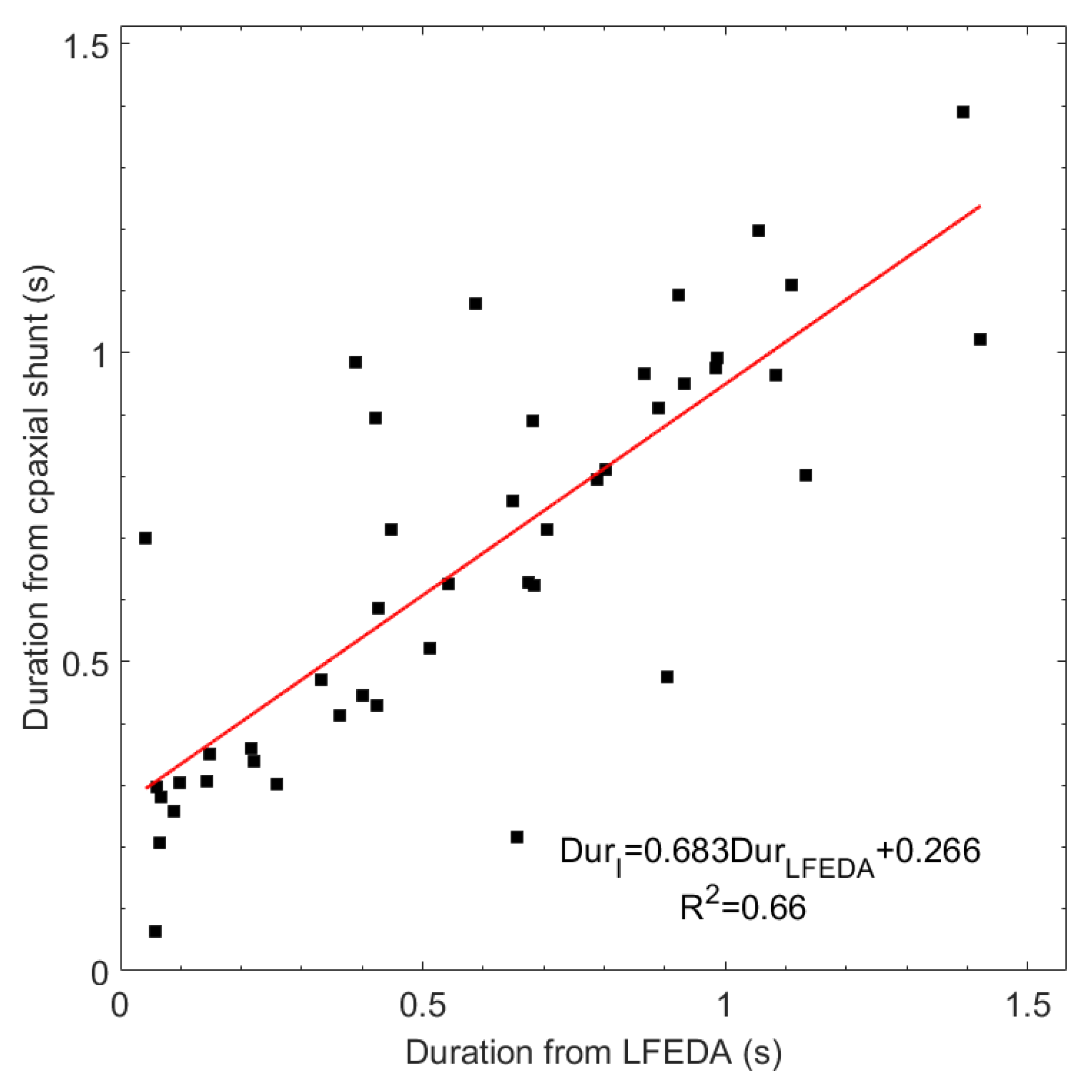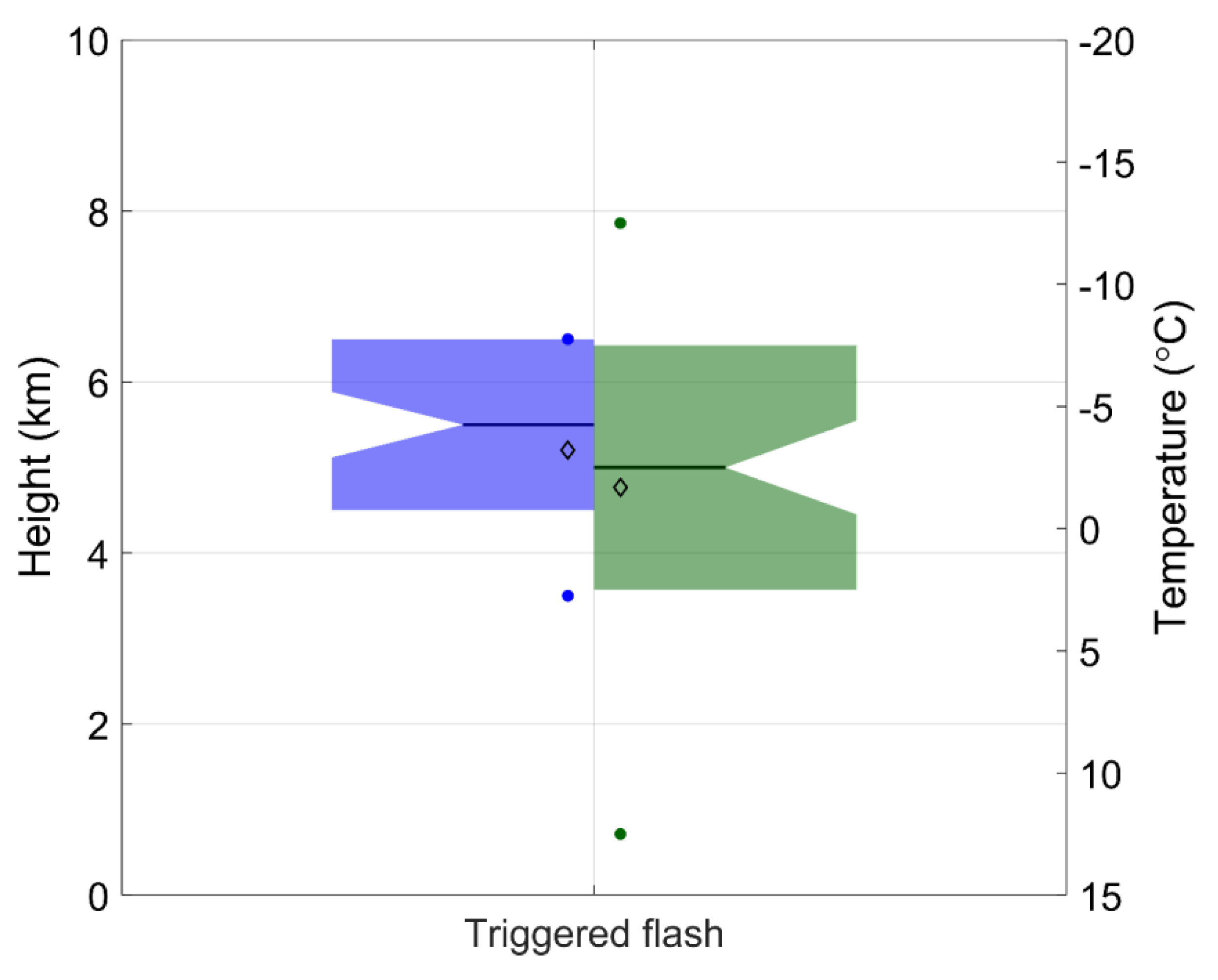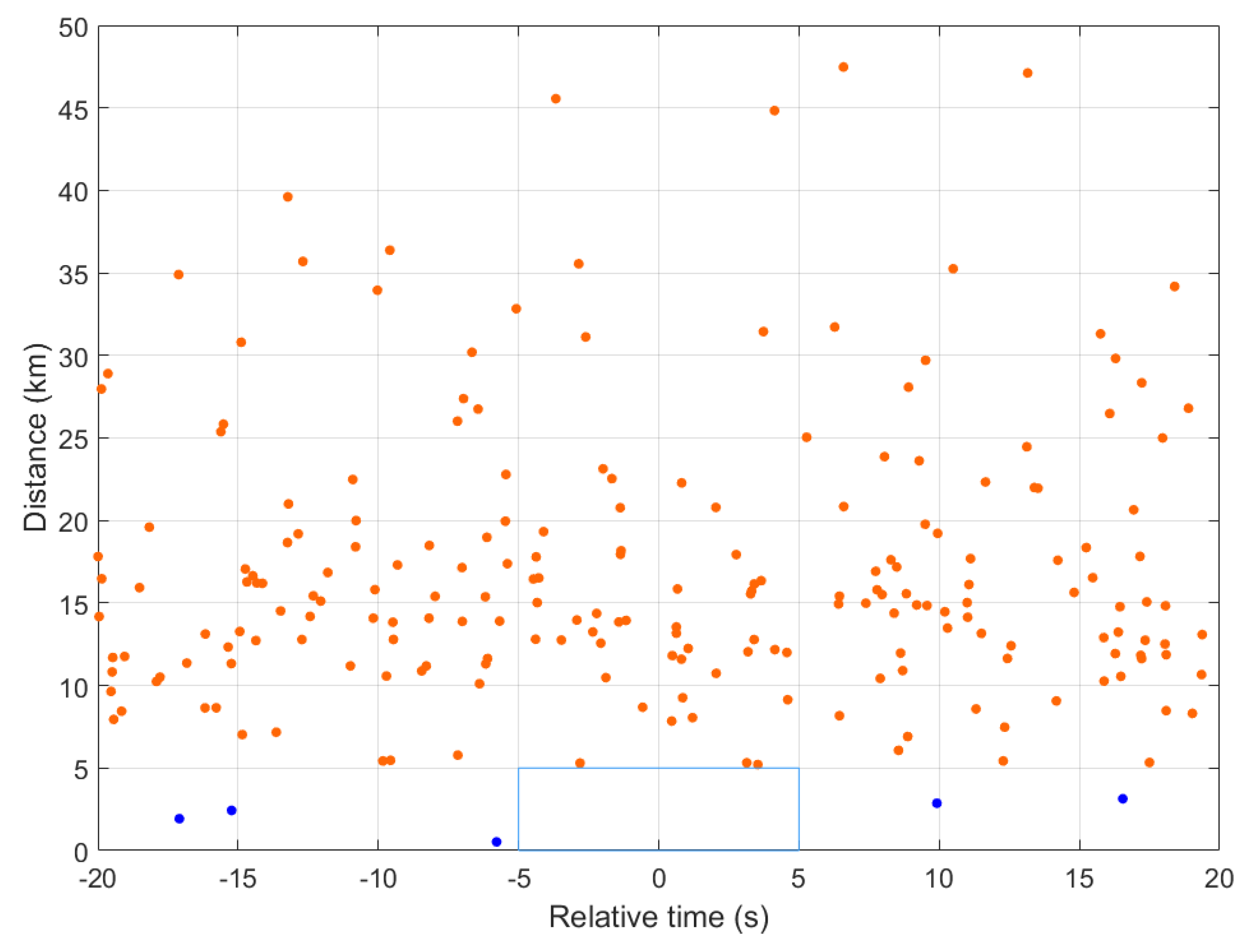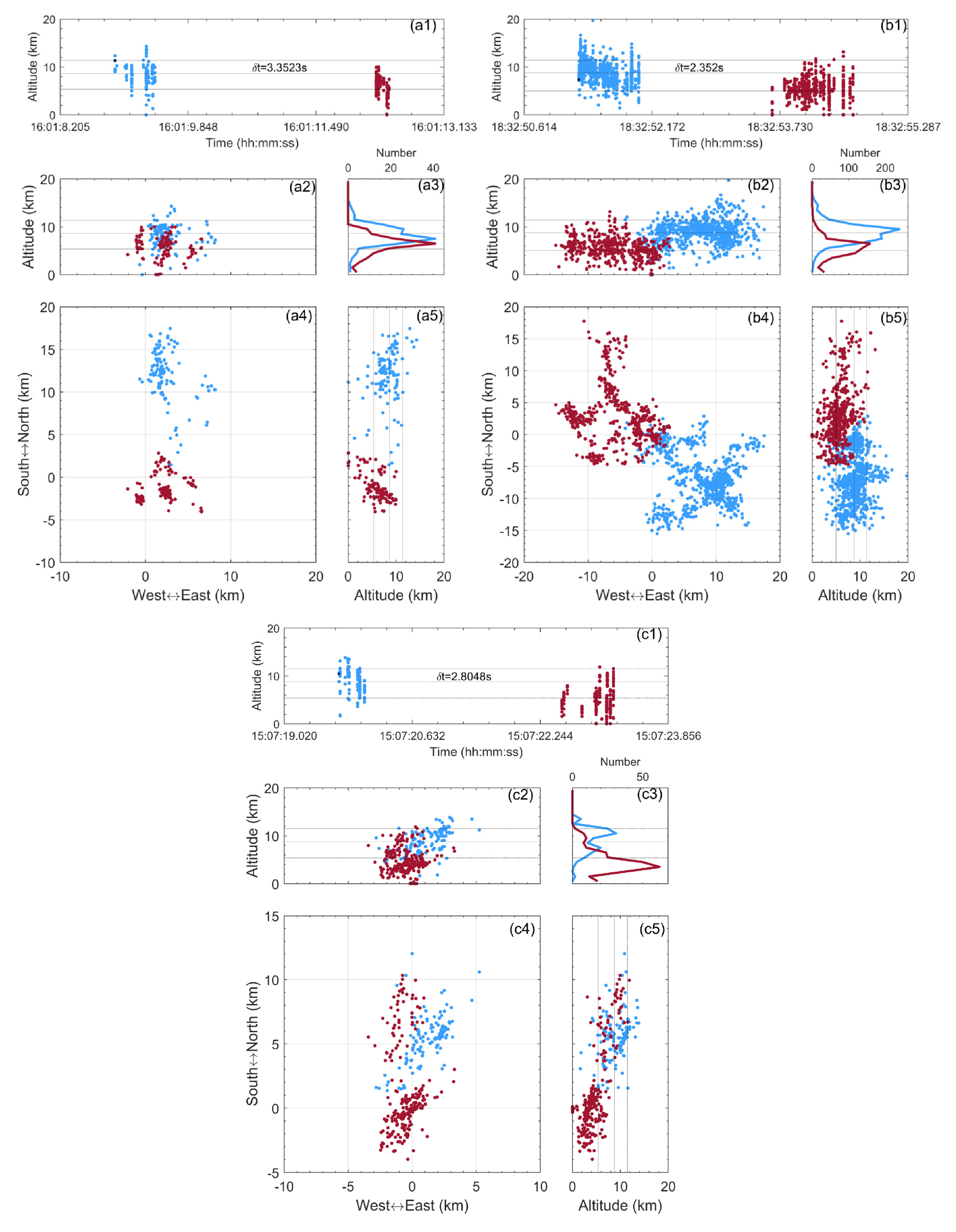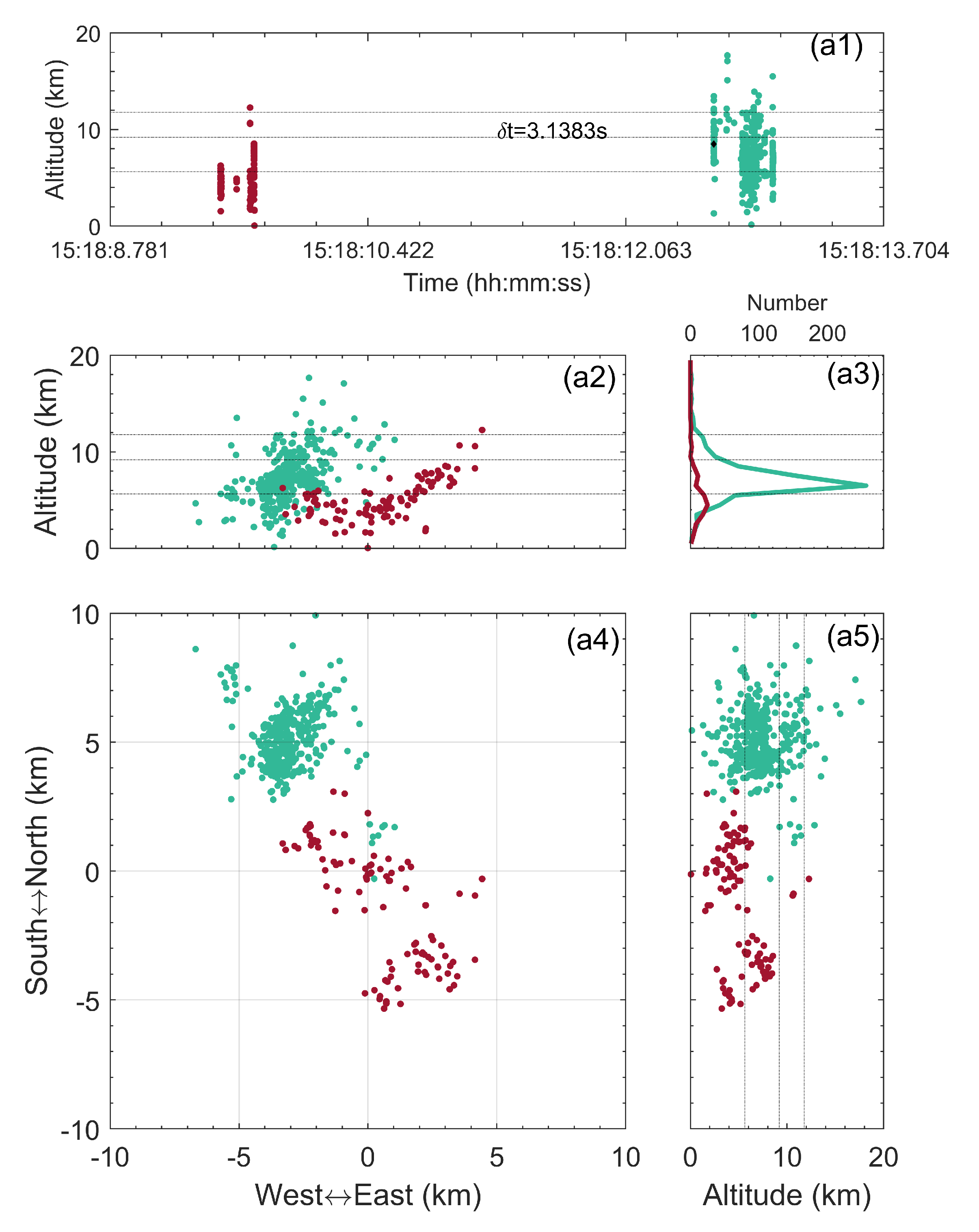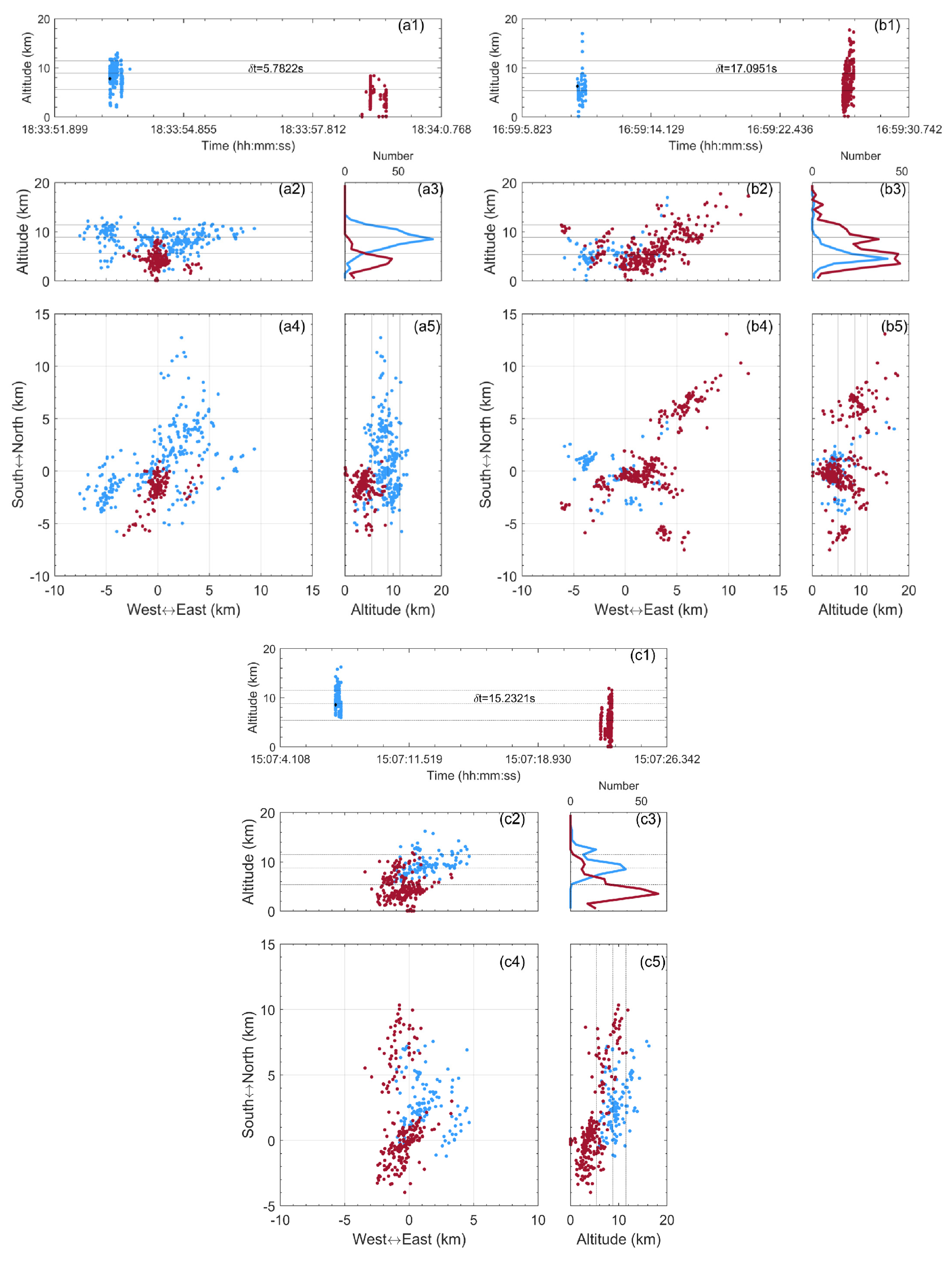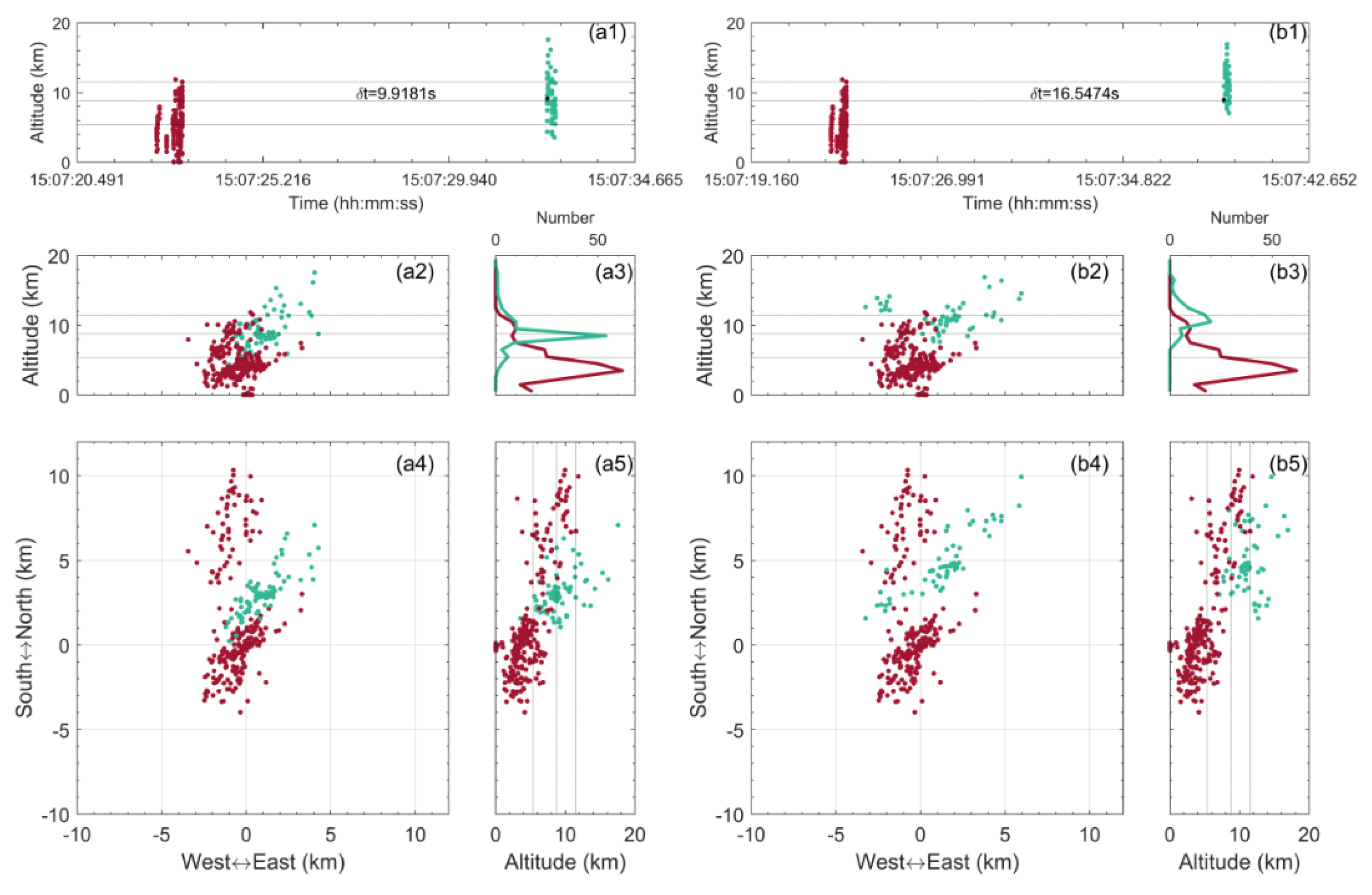3.1. TLF-Related Charge Region
All TLFs were negative in polarity, which means that the negative charges in the cloud were drained to the ground. The lightning channel typically propagates towards a region with high charge density; therefore, the concentration regions of the sources are usually the positions of the main charge regions involved in the discharges [
14,
16,
17]. Therefore, by counting the peak heights of the TLF sources, we obtained the positions of the negatively charged core region in the vertical direction.
Figure 5 shows their distribution in terms of height and ambient temperature. The negative charge region associated with the TLF was predominantly distributed from 3.5 to 6.5 km in height, with an average height of 5.2 km and a median height of 5.5 km; the corresponding ambient temperatures were about 12.5 to −12.5, −1.7 and −2.5 °C, respectively. MacGorman et al. [
18] analyzed the locations of three TLFs using a lightning mapping array in Florida and found that lightning channels mainly propagated in the negative charge region near the melting layers; the results of this study are in general agreement with their results.
The TLF source locations provide an approach for estimating the horizontal extent of the effective negative charge region (ENCR) associated with the TLF. The ENCR indicates the region where the charge density is sufficiently large to support the propagation of the TLF channels. The lightning channels propagate within a high-density charge region; therefore, some studies have used the spatial extent of lightning channels to characterize the size of the charge region [
19,
20,
21,
22,
23,
24,
25]. We referred to some of the parameters used in the cited literature, such as the lightning length (the furthest distance of any two sources involved in a flash, indicated using dashed line in
Figure 3c) and the lightning convex hull area (the convex hull is a polygon that delineates all the lightning sources with the smallest area, indicated by the polygon in
Figure 3c). In the analysis, some sources that were manually discriminated to be beyond the lower charge region directly associated with the TLFs were excluded from the calculation. The horizontal extension length of the TLFs (ENCR) ranged from 2.1 to 26.1 km, with a mean of 9.1 km and a median of 8.1 km. With regard to the convex hull area, the corresponding values were from 2.6 to 451.9, 83.9, and 54.3 km
2. If using a circle to represent the ENCR that had the same area as the convex hull, we would calculate the diameter of the ENCR to be 10.3 km (mean) and 8.3 km (median), close to the ENCR horizontal extension length indicated by the TLF length.
3.2. Spatiotemporal Isolation of TLFs
We first looked for NLFs at 1 km intervals within a range of 1–15 km radii from the flash-triggered point within 3, 5, 7, and 10 s before and after the TLFs. There were two scenarios: (1) the lightning channel entered the corresponding areas; and (2) the lightning was initiated in the corresponding areas. Based on previous studies, lightning initiation was considered as the first source of LFEDA lightning [
12,
14]. The subjects in the statistics were TLFs. That is, for a TLF, as long as a situation corresponding to (1) or (2) existed in the determined spatiotemporal range, it was recorded as one event, regardless of the number of NLFs (but should be greater than zero). We also used the term “event” for the relevant description.
Figure 6 shows the number of events at different distances from the flash-triggered position (from 1 to 15 km with a 1 km bin) and different statistical time (3, 5, 7, and 10 s before and after the TLFs). Events meeting the above conditions grew with an increase in the statistical time and distance range. Meanwhile, the increasing tendencies of the event number were greater in the ranges far from the flash-triggered position. The increase speeds within the 5 km range were apparently slower than those outside the 5 km range, as the distance from the flash-triggered position increased. In the case of the NLF channel entering the investigated areas within 3, 5, 7, and 10 s before the TLF, the increase rates of the number of events within 5 km were 0.4, 0.6, 0.8 and 1.4 per km, respectively, compared with 1.0, 1.8, 2.3, and 3.0 per km, respectively, in the range of 5−15 km. For the case of the NLF channel entering the investigated areas within 3, 5, 7, and 10 s after the TLF, the increase rates of the number of events were 0.4, 0.4, 0.4, and 0.8 per km within 5 km, respectively, and 1.4, 1.9, 2.2, and 3.0 per km in the range of 5–15 km, respectively.
Thus, the range of 5 km from the flash-triggered position can be regarded as a region that reflects the isolation of the TLFs in space. Two, three, four, and seven events with NLF channels entered this area within 3, 5, 7, and 10 s before the TLFs accounted for approximately 2.9%, 4.1%, 5.9%, and 10.3% of the TLF samples, respectively. The corresponding values were 2, 2, 2, and 4 events, and approximately 2.9%, 2.9%, 2.9%, and 5.9% of the sample, respectively, within 3, 5, 7, and 10 s after the TLFs.
Figure 7 shows the scattered initiation points of the NLFs at a distance from the flash-triggered position and time from the TLF. In terms of distance, 5 km was still a relatively evident demarcation; in the statistical time range of 20 s before and after the TLFs, the events corresponding to the NLFs initiated within and beyond 5 km were the least and most in number, respectively. For the 68 TLFs, there was no corresponding NLF initiated within a 5 km radius from the flash-triggered position, and within 5 s before and after their occurrence. At 10 and 20 s before the TLFs, there were one and three events in which the initiations of NLFs were located within a 5 km radius of the flash-triggered position. In the 20 s after the TLF, there was one event in which one TLF corresponded to two NLFs initiated within 5 km distance of the flash-triggered position.
According to the above analysis, a time of 5 s and spatial distance of 5 km were able to describe the spatiotemporal isolation of approximately 93% of the TLFs. The temporal parameter of 5 s was significantly smaller than the 10 s estimated by Zhang et al. [
10] based on the change in AAEF, whereas the spatial distance of 5 km was close to the upper end of their estimation values based on acousto-optic differences. In addition, it is interesting to note that some NLFs could still occur very close to TLFs spatiotemporally. Further analyses will be conducted on these cases.
3.3. Scenario That NFL Channels Entered into a 5 km Radius from the Flash-Triggered Position within 5 s before and after the TLFs
There were a total of five TLFs within 5 s before and after that the channels of the five NLFs propagated within a 5 km radius from the triggered lightning point. In three events, the NLFs occurred before the TLFs, and in the other two, after the TLFs.
The horizontal and vertical distributions of the sources of the three TLFs and their corresponding NLFs are shown in
Figure 8. As previously mentioned, the peak height of the sources was referred to as the position of the charge region core where lightning discharges were involved. The TLFs were all negative, thus, the intra-cloud channels directly associated with them should propagate in the negative charge region. Therefore, the peak heights of their sources generally represent the position of the negative charge core. For NLFs, at least two opposite-polarity charge zones are involved in the discharges, because of the bidirectional propagation of leaders [
14,
25,
26,
27]. The height distributions of the sources displayed one or two main peaks. One peak typically corresponded to the core position of one of the main charge regions, and two peaks possibly corresponded to the positions of the two main charge regions [
14,
16,
17].
One NLF occurred approximately 3.35 s before the TLF named T20150612160111, and its channels propagated approximately 3.20 km from the flash-triggered position (
Figure 8a). The height of the negatively charged core associated with the TLF was 6.5 km, corresponding to an ambient temperature of approximately −8 °C. The peak height of the NLF sources was located at 7.5 km or an ambient temperature of approximately −14 °C. There was a large overlap between the NLF and TLF sources in height (
Figure 8(a3)), implying that there might be a charge layer involved in both the discharges of the NLF and TLF. However, by checking the 3-D spatial distribution of their sources, we found that the channels of the TLF and NLF were separated from each other. In the horizontal plane (
Figure 8(a4)), the NLF channels were mainly located north of the flash-triggered position, whereas the TLF channels mainly propagated southward. These results suggest that the NLF and subsequent TLF might neutralize the charges at different positions, although some of these charges might occur in the same charge layer.
The second case corresponded to the TLF named T20150813183254, which was approximately 2.35 s preceded by an NLF whose channels propagated to a position approximately 0.40 km from the flash-triggered position (
Figure 8b). The NLF and TLF showed spatial separation in the horizontal distributions of their channels (
Figure 8(b4)). Most of the NLF channels appeared to the southeast of the flash-triggered position, whereas the TLF channels mainly propagated westward and northward. According to
Figure 8(b3), the peak source height of the NLF was located at 9.5 km (ambient temperature of approximately −25 °C), significantly higher than that of its TLF (about 6.5 km and −7 °C level, respectively). There were both TLF and NLF channels between 0 and −20 °C levels, but their horizontal areas were significantly different. Above the flash-triggered position, the TLF and NLF partially overlapped in their horizontal distributions (
Figure 8(b4)), but the NLF sources were generally higher than the TLF sources, with the NLF sources within a 2 km radius of the flash-triggered position having a peak height of 9 km, while the TLF turning its channel direction from upward to horizontal at approximately 5 km (
Figure 8(b2,b5)). Therefore, the lower negative charge region associated with this TLF might also be involved in the discharges of the NLF, but charges neutralized by them should be in different horizontal positions.
Figure 8c shows the third TLF (named T20170710150722) and an NLF occurring approximately 2.80 s before it, the channels of which propagated at the nearest about 1.68 km from the flash-triggered position. In the plan view (
Figure 8(c4)), the NLF was located in the area to the north of the flash-triggered position, while the main part of the TLF was located near to and south of the flash-triggered position; some sources were also located north of the flash-triggered position. The northern sources were grouped into TLF using the flash algorithm. However, they were predominantly distributed between 0 and −40 °C isotherms, with the peak height being 9.5 km (about −20 °C level), significantly different from the sources around the flash-triggered position, which were mainly distributed under the 0 °C isotherm and had a peak height of 3.5 km. Therefore, these two sources should correspond to layers with different charge layers. The current data suggest that this TLF is negative in polarity, and considering that the northern sources were visually separated from the sources around the flash-triggered position, we speculated that the northern sources might belong to a flash that was induced by the abrupt EF change in the cloud caused by the TLF (because the northern sources were relatively later in the time sequence) or a standalone intra-cloud flash that partly coincided with the TLF in time. We then considered the sources around the flash-triggered position as the body of the TLF. The spatial distributions of the NLF and TLF showed that they were generally separated from each other in both the horizontal and vertical directions. The NLF was mainly located to the north of the TLF, with two peak source heights (main peak of 10.5 km and secondary peak of 7.5 km) that were significantly higher than the source peak height of the TLF (3.5 km). Therefore, it was deduced that the TLF and NLF neutralized the charges in the different charge layers. The northern sources that were grouped into the TLF by the flash algorithm coincided with those of the NLF in height, but they were separated in the horizontal plane, indicating their association with the same charge layers but different charge positions.
There were two TLFs, after which the channel of the two natural lightning flashes propagated into the 5 km radius of the flash-triggered position within 5 s. The TLF named T20160614183449 was followed 3.54 s later by an NLF, the nearest distance of which from the flash-triggered position was 4.97 km. The LFEDA located only 12 sources for this natural lightning, which are not shown here. These sources were distributed between 6.5 and 9.5 km in height, corresponding to the levels between approximately −6 and −25 °C. The horizontal extension was approximately 1 km. Therefore, the channel of this NLF developed predominantly in the vertical direction, indicating that this NLF might have just developed an initial leader [
14]. The core of the sources of this TLF was at 5.5 km in height, corresponding to an ambient temperature of approximately −1 °C. There was a clear spatial separation of the TLF from the NLF in both height and horizontal positions, implying that they were formed by different charge layers.
Figure 9 shows the TLF named T20190702152112 and the subsequent NLF that occurred 3.14 s after it. The NLF channels propagated to the nearest 0.39 km from the flash-triggered position. In general, the TLF and NLF occurred in different spatial regions. The NLF sources were located northwest of the flash-triggered position and had a peak height of 6.5 km. The TLF propagated its channels towards the northwest and southeast, with the latter being the main direction. The northwestern channels of the TLFs did not overlap with those of the NLF in the horizontal and vertical directions. The peak height of the TLF sources was located at 4.5 km, with the main parts of the sources near the flash-triggered position being below the 0 °C layer, and the southern parts being below −20 °C layer. In the vicinity of the flash-triggered position, some of the TLF and NLF sources coincided horizontally, but they were apparently vertically separated. Therefore, the NLF and TLF should occur in different charge layers near the flash-triggered positions.
3.4. Scenarios Where NFLs Were Initiated within a 5 km Radius from the Flash-Triggered Position within 20 s before and after the TLFs
There were a total of four TLFs that corresponded to five NLFs initiated within a 5 km radius of the flash-triggered position and within 20 s before and after the TLFs. Among the NLFs, three appeared before three TLF and two appeared after the same TLF.
Figure 10a shows the TLF named T20160609183358; the NLF initiated at 0.52 km from the flash-triggered position and 5.78 s before the TLF. They had an evident overlap in the horizontal distribution (
Figure 10(a4)), but a difference in the height distribution (
Figure 10(a2,a3,a5)). First, the sources of the NLF were mostly concentrated around a height of 8.5 km, corresponding to an ambient temperature of about −18 °C, while most of the sources were located above the 0 °C layer. In contrast, the peak height of the TLF sources was 4.5 km, corresponding to an ambient temperature of approximately 3 °C, whereas most of the sources were located below the 0 °C isotherm. Above the flash-triggered position, the TLF sources mainly occurred below 6 km, whereas the NLF sources were generally above this height. Therefore, the TLF and NLF should be associated with different charge layers.
An NLF was initiated approximately 1.93 km from the flash-triggered position and 17.10 s before the TLF named T20160615165926, as shown in
Figure 10b. Their channels clearly overlapped in the horizontal and vertical directions. The TLF sources were mostly concentrated at a height of 3.5–5.5 km, or an ambient temperature of approximately 11 to −1 °C. Meanwhile, some sources grouped into the TLF were located at higher positions and caused a second concentration height of 8.5 km, corresponding to an ambient temperature of about −18 °C. Furthermore, there were some sources above 8.5 km. The wide vertical distribution of sources associated with TLF indicates that multiple charge layers might have been involved. Because of the negative polarity of the TLF, it was indicated that the sources located at relatively high positions might belong to the discharges induced by the TLF (their time was behind the initiation of the TLF), or a single flash partially coinciding with the TLF in time but were grouped into the TLF by the flash algorithm, similar to the TLF shown in
Figure 8c. In addition to the intersection of the TLF and NLF channels in the horizontal plane, the sources of the NLF peaked at a height of 4.5 km, falling in the peak height range of the TLF sources. Therefore, the lower negative-charge region associated with the TLF took part in the previous NFL discharge. A time interval of 17.10 s between them indicated the recovery time of the lower negative charge. The ground electric field recorded the AAEF change caused by natural lightning 17 s before the AAEF change caused by the TLF; however, the former AAEF change was small (not the same magnitude as the AAEF change corresponding to the TLF).
The NLF shown in
Figure 10c was initiated at approximately 2.43 km from the flash-triggered position and 15.23 s before the TLF. The TLF was the same as that shown in
Figure 8c, and the sources around the flash-triggered position were considered to be the body of the TLF. The NLF sources suggested two distribution peaks in height: the main peak at 8.5 km (approximately −18 °C) and the second peak at 12.5 km (approximately −49 °C), respectively, apparently different from the 3.5 km peak height (approximately 9 °C) of the TLF sources. Therefore, the NLF and TLF should be associated with different charge layers.
The TLF shown in
Figure 11 was similar to the case shown in
Figure 8c and
Figure 10c. It was followed by two NLFs initiated at a horizontal distance of about 2.87 and 3.14 km from the flash-triggered position at approximately 9.92 and 16.55 s after the TLF, respectively. In terms of the distribution of the sources in height, the two NLFs had the peak heights of 8.5 km (approximately −18 °C) (
Figure 11a) and 10.5 km (approximately −32 °C) (
Figure 11b), respectively, significantly higher than the 3.5 km (about 9 °C) peak height of the TLF sources. Based on the horizontal and vertical distributions of the body of the TLF and the two NLFs, we deduced that the TLF corresponded to a charge layer different from the NLFs. Furthermore, the two NLFs probably originated from adjacent areas.
